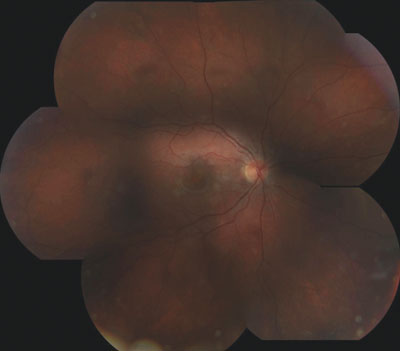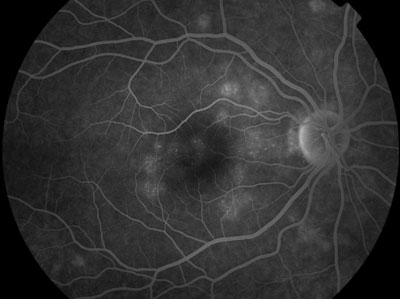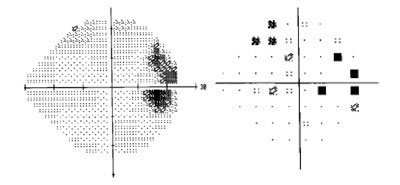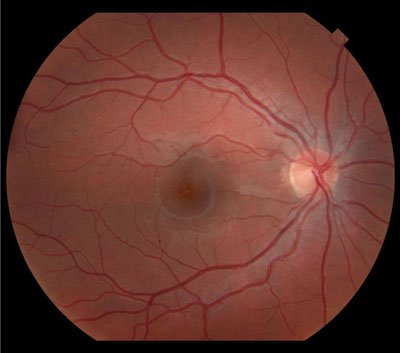Woman sees shimmering spots in right eye
A dilated fundus exam showed multiple white lesions in the posterior pole.
 Priti Batta |
 Namrata Nandakumar |
A 21-year-old woman noticed multiple “small shimmering spots” in her right eye for 2 days. She had no eye pain, floaters, headache or history of a viral illness. She was in good health and did not take any medications. Her ocular history was unremarkable.
On examination, the patient’s best corrected visual acuity was 20/25 in the right eye and 20/20 in the left eye. Her pupils were equally round and reactive to light with no relative afferent pupillary defect. Extraocular movements were full. IOP was 16 mm Hg in the right eye and 15 mm Hg in the left eye. Slit lamp examination was significant for 1+ cell in the anterior chamber of the right eye. No vitreous cells were present. Dilated fundus examination of the right eye showed multiple white spots at the level of the retinal pigment epithelium, mainly nasally and close to the fovea. The fovea itself had a granular appearance (Figure 1). A dilated fundus exam of the left eye was unremarkable.
 Figure 1. Fundus photograph of the right eye showing multiple white lesions. Images: Semela LB, Rogers A
|

What is your diagnosis?
Photopsias, unilateral white fundus lesions
The patient’s clinical presentation of unilateral photopsias and the retinal finding of white fundus lesions were suggestive of a white dot syndrome. White dot syndromes are inflammatory entities affecting the retina, retinal pigment epithelium (RPE) or choroid. They are multifocal in nature and typically affect younger patients between the second and sixth decade.
Our patient’s clinical presentation and findings on exam were most consistent with a diagnosis of multiple evanescent white dot syndrome (MEWDS). Fluorescein angiography showed a wreath-like configuration of the hyperfluorescent dots characteristically seen in MEWDS (Figure 2). On automated perimetry visual field testing, an enlarged blind spot, another common finding, was detected in the right eye (Figure 3).
 Figure 2. Fluorescein angiography (5 min., 12 sec.) of the right eye showing a wreath-like configuration of hyperfluorescent dots. |
 Figure 3. HVF 24-2 of the right eye. Enlarged blind spot. |
Differential diagnosis
The differential diagnosis of MEWDS includes acute posterior multifocal placoid pigment epitheliopathy (APMPPE), birdshot retinochoroidopathy and multifocal choroiditis. Lymphoma and sarcoidosis can present with yellow choroidal infiltrates but are unlikely given the presentation of our case.
APMPPE is a bilateral disease that affects young adults in the second and third decades of life. Men and women are affected equally. A viral prodrome is common. The yellow, creamy-colored, placoid choroidal lesions are larger than in MEWDS and are of variable size. Fluorescein angiography shows early hypofluorescence and late hyperfluorescence with staining of the lesions. The disease course is self-limited with a good visual outcome, but residual RPE mottling and alterations often remain. Recurrences are rare.
In contrast to our case, birdshot retinochoroidopathy is a bilateral disease and usually affects women between the third and sixth decades of life. Multifocal depigmented patches are scattered throughout the entire fundus, and vitritis is present. Cystoid macular edema, disc edema and narrowed retinal vessels are typical findings on exam. The long-term visual prognosis is guarded. Steroids or steroid-sparing immunomodulatory agents are used to treat patients with birdshot retinochoroidopathy. Approximately 90% of patients are HLA-A29 positive.
Multifocal choroiditis is mostly a bilateral disease and presents predominantly in women between the second and sixth decades of life. Patients present with decreased visual acuity. On exam, most patients have anterior and posterior segment inflammation. The acute choroidal lesions on fundus exam are variable in size and number. Older lesions appear atrophic with pigment changes. Choroidal neovascularization may occur. Fluorescein angiography shows early blockage and late staining of acute lesions. Treatment consists of steroids to reduce inflammation.
Discussion
Given our patient’s presentation and clinical findings, we diagnosed her with MEWDS. MEWDS is an inflammatory chorioretinopathy that affects mainly young, healthy women in the second to fourth decades of life. A flu-like prodrome is present in about one-half of the patients. Patients usually present with acute, unilateral, painless visual loss. Shimmering photopsias are a common complaint. Findings on ocular exam include characteristic white spots at the level of the RPE or deep retina in the posterior pole. The fovea typically has a granular appearance. The diagnosis of MEWDS is made by the typical clinical findings on exam. Fluorescein angiography shows hyperfluorescence of the fundus lesions in a wreath-like pattern as well as hyperfluorescence of the optic disc corresponding to an enlarged blind spot seen on automated perimetry visual field testing. Electrophysiological studies show a decreased A-wave amplitude on the electroretinogram, suggesting photoreceptor dysfunction.
As the term evanescent implies, MEWDS has a self-limited course, and no treatment is necessary. Within 2 to 6 weeks, the white lesions fade and the disc edema gradually resolves. The visual acuity gradually returns to baseline. However, the photopsias may take months to resolve. The granular appearance of the fovea is usually permanent. The visual prognosis is good in patients with MEWDS, and recurrences are uncommon.
Follow-up
Our patient’s visual acuity returned to 20/20 in the affected eye over the course of 1 month. Her fundus examination showed a few remaining white dots and persistent granularity of the fovea (Figure 4).
 Figure 4. One-month follow-up fundus photograph of the right eye. Most of the white dots resolved. The foveal granularity persisted. |
References:
- Aaberg TM, Campo RV, Joffe L. Recurrences and bilaterality in the multiple evanescent white-dot syndrome. Am J Ophthalmol. 1985;100(1):29-37.
- Gass JD. Vitiliginous chorioretinitis. Arch Ophthalmol. 1981;99(10):1778-1787.
- Jampol LM, Sieving PA, Pugh D, Fishman GA, Gilbert H. Multiple evanescent white dot syndrome. 1. Clinical findings. Arch Ophthalmol. 1984;102(5):671-674.
- Morgan CM, Schatz H. Recurrent multifocal choroiditis. Ophthalmology. 1986; 93(9):1138-1147.
- Ryan SJ, Maumenee AE. Birdshot retinochoroid-opathy. Am J Ophthalmol. 1980;89(1):31-45.
- Shah KH, Levinson RD, Yu F, et al. Birdshot chorio-retinopathy. Surv Ophthalmol. 2005;50(6):519-541.
- Linda Brenner Semela, MD, and Adam Rogers, MD, can be reached at New England Eye Center, Tufts University School of Medicine, 750 Washington St., Box 450, Boston, MA 02111; 617-636-4219; fax: 617-636-4866; website: www.neec.com.
- Edited by Priti Batta, MD, and Namrata Nandakumar, MD. Drs. Batta and Nandakumar can be reached at New England Eye Center, Tufts University School of Medicine, 750 Washington St., Box 450, Boston, MA 02111; 617-636-4219; fax: 617-636-4866; website: www.neec.com.

